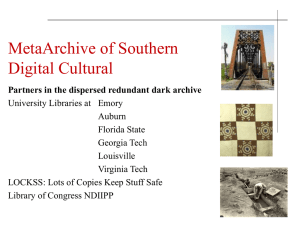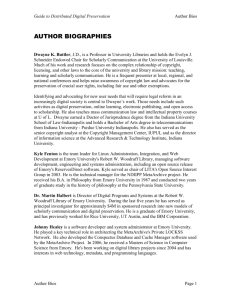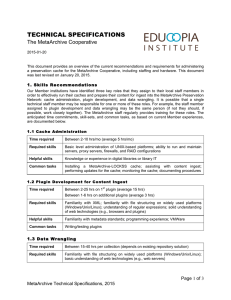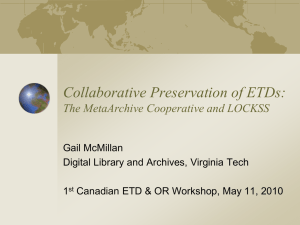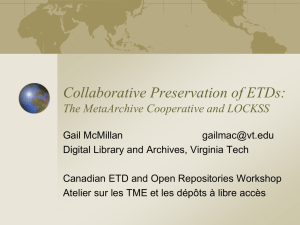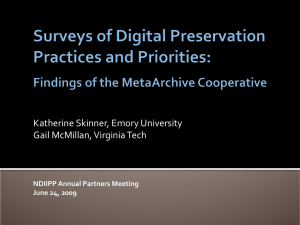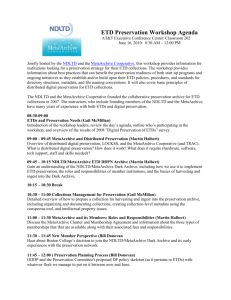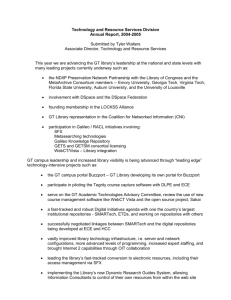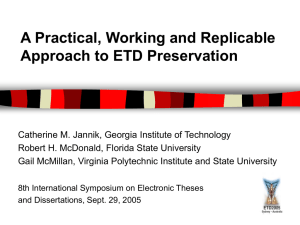MetaArchive of Southern Digital Cultural
advertisement
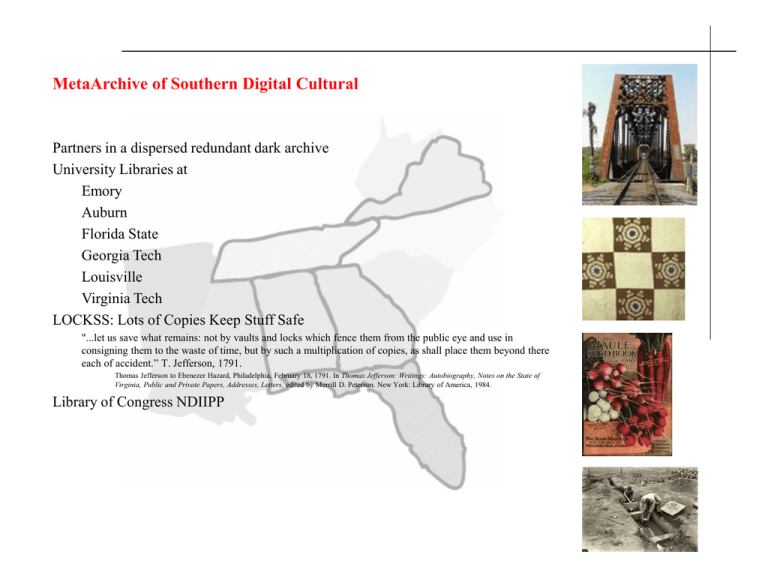
MetaArchive of Southern Digital Cultural Partners in a dispersed redundant dark archive University Libraries at Emory Auburn Florida State Georgia Tech Louisville Virginia Tech LOCKSS: Lots of Copies Keep Stuff Safe "...let us save what remains: not by vaults and locks which fence them from the public eye and use in consigning them to the waste of time, but by such a multiplication of copies, as shall place them beyond there each of accident.” T. Jefferson, 1791. Thomas Jefferson to Ebenezer Hazard, Philadelphia, February 18, 1791. In Thomas Jefferson: Writings: Autobiography, Notes on the State of Virginia, Public and Private Papers, Addresses, Letters, edited by Merrill D. Peterson. New York: Library of America, 1984. Library of Congress NDIIPP MetaArchive Goals The MetaArchive of Southern Digital Culture will create and develop a digital preservation network for critical and at-risk content relating to Southern culture and history. The partners in this initiative will select and preserve institutional digital archives, including institutionally relevant materials such as electronic theses and dissertations, as well as ephemeral works such as online exhibitions and cultural history displays. This digital content will include subjects that complement Library of Congress collections covering the Civil War, the civil rights movement, slave narratives, Southern music, handicrafts, and church history. These collections will encompass born-digital works containing existing works as well as newly created digital works produced for web and other archival purposes. 1. Robust adaptable model for a network of partner institutions using open source software and off the shelf hardware: build on successful LOCKSS model 2. Preservation model a. Scalable b. Redundant copies c. Distributed storage d. Private access to multi-institutional partners only Challenges for the MetaArchive of Southern Digital Culture Scope definition • Meeting LoC and grant goals in context of our institutional goals: Southern culture • • Well-known events, e.g., Civil War Beyond the expected, e.g., ETDs from Southern universities reflect Southern culture Adapting a collection description/metadata schema • UKOLN RSLP (UK Office for Library Networking Research Support Libraries Programme) http://www.ukoln.ac.uk/metadata/rslp/schema/ • • • • • Risk ranking Manifest pages: MetaArchive partners have permission to collect, preserve, and serve this Archival Unit to MetaArchive partners. Dublin Core Collection Description Application Profile http://www.ukoln.ac.uk/metadata/dcmi/collection-application-profile/ Western Trails V 2.0 Document http://www.cdpheritage.org/resource/metadata/documents/WSDCMBP_v2-0.pdf IMLS DDC Collection Description Metadata Schema - detailed view http://imlsdcc.grainger.uiuc.edu/CDschema_elements.htm Hardware acquisitions and installations • • From small-scale, i.e., old desktops w/large hard drives To SATA SAN EMC AX100 11(serial advanced technology attachment, storage-area-network) • Kickstart: set up all alike simultaneously • MetaWikiAx100ArrayMiniHowto • http://metaarchive.org/files/ks.cfg Software: open source • • • Operating system: RedHat Enterprise Linux v. 4 Content ingest/replication: LOCKSS Conspectus database: MySQL/PHP Registry Communication • Telephone conference, video conference I2, iVocalize Chat/VOIP Room, Wiki, PhpCollab MetaArchive Rights Management Any use of protected works generally will need to: • fit within an exception to the exclusive rights of owners, such as the “fair-use” doctrine or other provisions relating specifically to library copying and other activities • undergo an investigation to determine whether the work still enjoys protection or has lapsed into the public domain due to notice or renewal defects • occur as a result of valid permission from the copyright owner(s) • constitute an acceptable risk for the institution in potential absence of “clear” resolution Beyond Rights Issues • Rights of publicity, e.g., names, images, likenesses • Rights of privacy: potential for damage • Common-law or state statutory protections • Apply to most restrictive jurisdiction? • Apply to widespread norm across jurisdictions? • What is the practical meaning of “infringement” in the context of a “dark archive?” • What kinds of limits currently exist in Sect. 108 that prevent or lessen its application to preservation efforts such as MetaArchive? • How can the law address works that have no “owner” in a practical sense from which to acquire permission to preserve?

